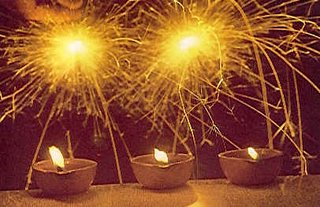
The ancient story of how Diwali evolved into such a widely celebrated festival is different in various regions and states of India.
In the north, Diwali is the day when King Rama's coronation was celebrated in Ayodhya after his epic war with Ravana, the demon king of Lanka. By order of the royal families of Ayodhya and Mithila, the kingdom of which Sita was princess, the cities and far-flung boundaries of these kingdoms were lit up with rows of lamps, glittering on dark nights to welcome home the divine king Rama and his queen Sita after 14 years of exile, ending with an across-the-seas war in which the whole of the kingdom of Lanka was destroyed.
In the south, Diwali has two more legends connected with it. The first legend again concerns the victory of good over evil. Narakasura the demon of hell, challenged Krishna to battle. After a fierce fight lasting two days, the demon was killed at dawn on Narakachaturdashi.To commemorate this event, people in peninsular India wake before sunrise and make imitation blood by mixing kumkum or vermillion with oil. After crushing underfoot a bitter fruit as a symbol of the demon, they apply the `blood' triumphantly on their foreheads. They then have ritual oil baths, annointing themselves with sandalwood paste. Visits to temples for prayers are followed by large family breakfasts of fruits and a variety of sweets.
In the north, Diwali is the day when King Rama's coronation was celebrated in Ayodhya after his epic war with Ravana, the demon king of Lanka. By order of the royal families of Ayodhya and Mithila, the kingdom of which Sita was princess, the cities and far-flung boundaries of these kingdoms were lit up with rows of lamps, glittering on dark nights to welcome home the divine king Rama and his queen Sita after 14 years of exile, ending with an across-the-seas war in which the whole of the kingdom of Lanka was destroyed.
In the south, Diwali has two more legends connected with it. The first legend again concerns the victory of good over evil. Narakasura the demon of hell, challenged Krishna to battle. After a fierce fight lasting two days, the demon was killed at dawn on Narakachaturdashi.To commemorate this event, people in peninsular India wake before sunrise and make imitation blood by mixing kumkum or vermillion with oil. After crushing underfoot a bitter fruit as a symbol of the demon, they apply the `blood' triumphantly on their foreheads. They then have ritual oil baths, annointing themselves with sandalwood paste. Visits to temples for prayers are followed by large family breakfasts of fruits and a variety of sweets.
The second legend is about King Bali, the benevolent demon king of the netherworld. He was so powerful that he became a threat to the power of celestial deities and their kingdoms. Intimidated by his expanding empire and taking advantage of his well-known generosity, they sent Vishnu as the dwarf mendicant Vamana, to dilute Bali's power. Vamana shrewdly asked the king for land that would cover three steps as he walked. The king happily granted this gift. Having tricked Bali, Vishnu revealed himself in the full glory of his godhood. He covered the heaven in his first step and the earth in his second. Realizing that he was pitted against the mighty Vishnu, Bali surrendered and offered his own head inviting Vishnu to step on it. Vishnu pushed him into the nether world with his foot. In return Vishnu gave him the lamp of knowledge to light up the dark underworld. He also gave him a blessing that he would return to his people once a year to light millions of lamps from this one lamp so that on the dark new moon light of Diwali, the blinding darkness of ignorance , greed, jealousy, lust, anger ego, and laziness would be dispelled and the radiance of knowledge, wisdom and friendship prevail. Each year on Diwali day , even today, one lamp lights another and like a flame burning steadily on a windless night, brings a message of peace and harmony to the world .
Source : http://www.reachgujarat.com/diwali.htm
Source : http://www.reachgujarat.com/diwali.htm
3 comments:
Very good information! Ultimately the underline is dispelling darkness; good agains evil!
All of you youngsters do a good job of learning the basics of India better than the children living here.
Keep it up.
Greetings for a very happy dipavali.
Enna, bayangarama in mythological mood ?
No mythological mood...I was just curious about the tradition and thought that it would be interesting to put it down and refresh our memories.
And I did not expect anyone to read it and surely did not expect the compliments from Padmasani !
Thank you !
Post a Comment